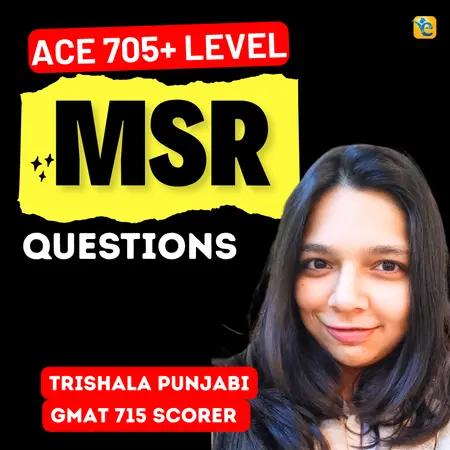Events & Promotions
|
|

GMAT Club Daily Prep
Thank you for using the timer - this advanced tool can estimate your performance and suggest more practice questions. We have subscribed you to Daily Prep Questions via email.
Customized
for You
Track
Your Progress
Practice
Pays
Not interested in getting valuable practice questions and articles delivered to your email? No problem, unsubscribe here.
- Nov 18
11:00 AM PST
-12:00 PM PST
Join us in a live GMAT practice session and solve 30 challenging GMAT questions with other test takers in timed conditions, covering GMAT Quant, Data Sufficiency, Data Insights, Reading Comprehension, and Critical Reasoning questions. - Nov 22
11:00 AM IST
-01:00 PM IST
Do RC/MSR passages scare you? e-GMAT is conducting a masterclass to help you learn – Learn effective reading strategies Tackle difficult RC & MSR with confidence Excel in timed test environment - Nov 23
11:00 AM IST
-01:00 PM IST
Attend this free GMAT Algebra Webinar and learn how to master the most challenging Inequalities and Absolute Value problems with ease. - Nov 25
10:00 AM EST
-11:00 AM EST
Prefer video-based learning? The Target Test Prep OnDemand course is a one-of-a-kind video masterclass featuring 400 hours of lecture-style teaching by Scott Woodbury-Stewart, founder of Target Test Prep and one of the most accomplished GMAT instructors.
Kudos
Bookmarks
A
Be sure to select an answer first to save it in the Error Log before revealing the correct answer (OA)!
Difficulty:
 15%
(low)
15%
(low)
Question Stats:
72% (01:05) correct 28%
(01:23)
wrong
28%
(01:23)
wrong  based on 9192
sessions
based on 9192
sessions
History
Date
Time
Result
Not Attempted Yet
Over the past ten years cultivated sunflowers have become a major commercial crop, second only to soybeans as a source of vegetable oil.
A. second only to soybeans as a source of vegetable oil
B. second in importance to soybeans only as a source of vegetable oil
C. being second in importance only to soybeans as a source of vegetable oil
D. which, as a source of vegetable oil, is only second to soybeans
E. as a source of vegetable oil only second to soybeans
(SC01507)
A. second only to soybeans as a source of vegetable oil
B. second in importance to soybeans only as a source of vegetable oil
C. being second in importance only to soybeans as a source of vegetable oil
D. which, as a source of vegetable oil, is only second to soybeans
E. as a source of vegetable oil only second to soybeans
(SC01507)
Kudos
Bookmarks
Hello Everyone!
First, let’s scan over the answers quickly and note any major differences. Next, we can narrow down the bad answers to get to the correct one!
After a quick scan, we can clearly see a few major differences to address:
1. Placement of the word “only”
2. Placement of the phrase “as a source of vegetable oil”
3. Use of the phrase “in importance”
To start, let’s look at the difference between saying “second only to” and “only second to” to figure out which one we need:
X is second only to Y = only Y can be better than X out of all the options available
X is only second to Y = X is second to Y, but may be first, third, or tenth compared to other options available
Based on the meaning of both options, it makes the most sense to keep answers that use the “X is second only to Y.” To test this out, let’s add “sunflowers are” to the beginning of each answer to see if they work:
A: “sunflowers are second only to soybeans…” → OK
B: “sunflowers are second to soybeans only…” → WRONG
C: “sunflowers are second…only to soybeans…” → OK
D: “sunflowers are…only second to soybeans…” → WRONG
E: “sunflowers are...only second to soybeans…” → WRONG
Only answers A and C correctly use “X is second only to Y” and keep the original meaning, so let’s toss out the other three answers right away.
Now we’re left with just A and C. Let’s look at both answers together to find a clear winner
A. second only to soybeans as a source of vegetable oil.
This answer is CORRECT because it uses the proper structure of “X is second only to Y,” and it doesn’t include any redundant or unnecessary words.
C. being second in importance only to soybeans as a source of vegetable oil.
This answer is INCORRECT because there are added words in the answer that are unnecessary. The word “being” doesn’t add anything to the sentence’s meaning, and the phrase “in importance” is redundant. We can safely assume if things are being ranked in some way, they are ranked by order of importance.
That leaves us with the correct answer, A!
Don’t study for the GMAT. Train for it.
First, let’s scan over the answers quickly and note any major differences. Next, we can narrow down the bad answers to get to the correct one!
After a quick scan, we can clearly see a few major differences to address:
1. Placement of the word “only”
2. Placement of the phrase “as a source of vegetable oil”
3. Use of the phrase “in importance”
To start, let’s look at the difference between saying “second only to” and “only second to” to figure out which one we need:
X is second only to Y = only Y can be better than X out of all the options available
X is only second to Y = X is second to Y, but may be first, third, or tenth compared to other options available
Based on the meaning of both options, it makes the most sense to keep answers that use the “X is second only to Y.” To test this out, let’s add “sunflowers are” to the beginning of each answer to see if they work:
A: “sunflowers are second only to soybeans…” → OK
B: “sunflowers are second to soybeans only…” → WRONG
C: “sunflowers are second…only to soybeans…” → OK
D: “sunflowers are…only second to soybeans…” → WRONG
E: “sunflowers are...only second to soybeans…” → WRONG
Only answers A and C correctly use “X is second only to Y” and keep the original meaning, so let’s toss out the other three answers right away.
Now we’re left with just A and C. Let’s look at both answers together to find a clear winner
A. second only to soybeans as a source of vegetable oil.
This answer is CORRECT because it uses the proper structure of “X is second only to Y,” and it doesn’t include any redundant or unnecessary words.
C. being second in importance only to soybeans as a source of vegetable oil.
This answer is INCORRECT because there are added words in the answer that are unnecessary. The word “being” doesn’t add anything to the sentence’s meaning, and the phrase “in importance” is redundant. We can safely assume if things are being ranked in some way, they are ranked by order of importance.
That leaves us with the correct answer, A!
Don’t study for the GMAT. Train for it.
Kudos
Bookmarks
Bunuel
Explaining why D is wrong:
Modifiers such as only and almost are known as LIMITERS.
A limiter serves to LIMIT the scope of another word in the sentence.
Generally, a limiter should be placed directly before whatever it is intended to limit.
ONLY JOHN plays the tuba.
Here, only serves to limit WHO PLAYS the tuba.
Conveyed meaning;
NO ONE ELSE -- aside from John -- plays the tuba.
John plays ONLY THE TUBA.
Here, only serves to limit WHICH INSTRUMENTS John plays.
Conveyed meaning:
John plays NO OTHER INSTRUMENTS -- aside from the tuba.
OA: Sunflowers have become...second ONLY TO SOYBEANS.
Here, only serves to limit WHICH CROPS are more important than sunflowers.
Conveyed meaning:
NO OTHER CROP -- aside from soybeans -- is more important than sunflowers.
D: A major commercial crop...is ONLY SECOND.
Here, only serves to limit WHICH RANKING is attributed to the major commercial crop.
Conveyed meaning:
NO OTHER RANKING -- aside from second -- is attributed to the major commercial crop.
In D, the position of only distorts the intended meaning of the original sentence.
Eliminate D.














